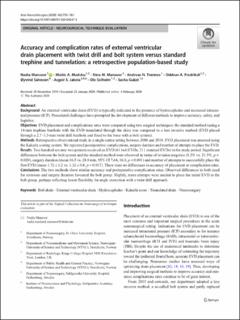| dc.contributor.author | Mansoor, Nadia Mauland | |
| dc.contributor.author | Madsbu, Mattis Aleksander | |
| dc.contributor.author | Mansoor, Nina M. | |
| dc.contributor.author | Trønnes, Andreas | |
| dc.contributor.author | Fredriksli, Oddrun | |
| dc.contributor.author | Salvesen, Øyvind | |
| dc.contributor.author | Jakola, Asgeir S | |
| dc.contributor.author | Solheim, Ole | |
| dc.contributor.author | Gulati, Sasha | |
| dc.date.accessioned | 2021-04-26T13:13:48Z | |
| dc.date.available | 2021-04-26T13:13:48Z | |
| dc.date.created | 2020-04-17T22:02:22Z | |
| dc.date.issued | 2020 | |
| dc.identifier.citation | Acta Neurochirurgica. 2020, 162 755-761. | en_US |
| dc.identifier.issn | 0001-6268 | |
| dc.identifier.uri | https://hdl.handle.net/11250/2739678 | |
| dc.description.abstract | Background: An external ventricular drain (EVD) is typically indicated in the presence of hydrocephalus and increased intracranial pressure (ICP). Procedural challenges have prompted the development of different methods to improve accuracy, safety, and logistics. Objectives: EVD placement and complications rates were compared using two surgical techniques; the standard method (using a 14-mm trephine burrhole with the EVD tunnelated through the skin) was compared to a less invasive method (EVD placed through a 2.7–3.3-mm twist drill burrhole and fixed to the bone with a bolt system). Methods: Retrospective observational study in a single-centre setting between 2008 and 2018. EVD placement was assessed using the Kakarla scoring system. We registered postoperative complications, surgery duration and number of attempts to place the EVD. Results: Two hundred seventy-two patients received an EVD (61 bolt EVDs, 211 standard EVDs) in the study period. Significant differences between the bolt system and the standard method were observed in terms of revision surgeries (8.2% vs. 21.5%, p = 0.020), surgery duration (mean 16.5 vs. 28.8 min, 95% CI 7.64, 16.8, p < 0.001) and number of attempts to successfully place the first EVD (mean 1.72 ± 1.2 vs. 1.32 ± 0.8, p = 0.017). There were no differences in accuracy of placement or complication rates. Conclusions: The two methods show similar accuracy and postoperative complication rates. Observed differences in both need for revisions and surgery duration favoured the bolt group. Slightly, more attempts were needed to place the initial EVD in the bolt group, perhaps reflecting lower flexibility for angle correction with a twist drill approach. | en_US |
| dc.language.iso | eng | en_US |
| dc.publisher | Springer | en_US |
| dc.relation.uri | https://link.springer.com/article/10.1007/s00701-020-04247-3 | |
| dc.rights | Navngivelse 4.0 Internasjonal | * |
| dc.rights.uri | http://creativecommons.org/licenses/by/4.0/deed.no | * |
| dc.title | Accuracy and Complication Rates of External Ventricular Drain Placement With Twist Drill and Bolt System Versus Standard Trephine and Tunnelation: A Retrospective Population-Based Study | en_US |
| dc.type | Peer reviewed | en_US |
| dc.type | Journal article | en_US |
| dc.description.version | publishedVersion | en_US |
| dc.source.pagenumber | 755-761 | en_US |
| dc.source.volume | 162 | en_US |
| dc.source.journal | Acta Neurochirurgica | en_US |
| dc.identifier.doi | 10.1007/s00701-020-04247-3 | |
| dc.identifier.cristin | 1806882 | |
| cristin.ispublished | true | |
| cristin.fulltext | original | |
| cristin.qualitycode | 1 | |

